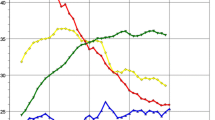Abstract
Lung cancer is the leading cause of cancer deaths in the United States representing about 25% of all cancer deaths. The risk from smoking has increased over time with racial/ethnic minorities and disadvantaged populations having higher smoking rates and experiencing greater burden of lung cancer compared to other populations. Rural populations, in particular, experience higher rates of tobacco usage associated with increased incidence of lung cancer. National efforts to identify lung cancer in its early stage would greatly benefit high-risk populations, consequently reducing advanced cancers and potentially decreasing smoking rates. In 2013, lung cancer screening with low-dose computed tomography was recommended by the US Preventive Services Task Force for early detection of lung cancer. These guidelines were developed after the results of the National Lung Screening Trial. The National Lung Screening Trial study showed a 20% reduction in deaths of participants who were current or former heavy smokers who were screened with low-dose computed tomography versus those screened by chest X-ray. In response to this evidence and using state lung cancer burden data and local smoking rates as a guide, Michigan implemented a lung cancer screening awareness campaign in the rural northern, lower peninsula. Awareness of lung cancer screening was increased through the use of a variety of media including gas station/convenience store small media, digital media, radio broadcast media, and the use and marketing of a website that provided lung cancer screening information and resources.






Similar content being viewed by others
Change history
29 August 2019
In the original publication of the article, the co-author name (Antoinette Percy-Laurry) was misspelled during the publication process. The coauthor name has been corrected in this correction.
29 August 2019
In the original publication of the article, the co-author name (Antoinette Percy-Laurry) was misspelled during the publication process. The coauthor name has been corrected in this correction.
References
Noone AM, Howlader N, Krapcho M, Miller D, Brest A, Yu M, Ruhl J, Tatalovich Z, Mariotto A, Lewis DR, Chen HS, Feuer EJ, Cronin KA (eds). (1975–2015). SEER cancer statistics review. National Cancer Institute, Rockville. https://seer.cancer.gov/csr/1975_2015/
A Report of the Surgeon General (2014) The health consequences of smoking: 50 years of progress. U.S. Department of Health and Human Services, Centers for Disease Control and Prevention, National Center for Chronic Disease Prevention and Health Promotion, Office on Smoking and Health, Washington, DC
Atkins GT, Kim T, Munson J (2017) Residence in rural areas of the United States and lung cancer mortality. Disease incidence, treatment disparities, and stage-specific survival. Ann Am Thorac Soc 14(3):403–411
The National Lung Screening Trial Research Team, Aberle DR, Adams AM, Berge CD, Black WC, Clapp JD, Faggerstrom RM, Gareen IF, Gatsonis C, Marcus PM, Sticks JD (2011) Reduced lung-cancer mortality with low-dose computed tomographic screening. N Engl J Med 365:395–409
Engelman A (2017) Health coalition forms national lung cancer roundtable to increase screening and reduce lung cancer deaths. American Cancer Society, Atlanta. http://pressroom.cancer.org/2017-03-23-Health-coalition-forms-National-Lung-Cancer-Roundtable-to-increase-screening-and-reduce-lung-cancer-deaths. Accessed 25 June 2018
U.S. National Cancer Institute (2017) A socioecological approach to addressing tobacco related health disparities. National cancer institute tobacco control monograph 22. U.S. National Cancer Institute, Rockville
U.S. National Cancer Institute (2018) State cancer profiles combined data from CDC’s national program of cancer registries and NCI’s surveillance, epidemiology and end results program, 2011–2015. U.S. National Cancer Institute, Rockville. http://statecancerprofiles.cancer.gov. Accessed 25 June 2018
Michigan Cancer Surveillance Program (2016) Age-adjusted invasive cancer incidence rates by county in Michigan, 2010–2014. Michigan Department of Health and Human Services, Lansing. http://cancer-rates.info/mi/. Accessed 25 June 2018
U.S. Census Bureau (2017) Quick facts, population estimates July 1, 2017. U.S. department of commerce. U.S. Census Bureau, Suitland. https://www.census.gov/quickfacts/fact/table/US/PST045217# Accessed 25 June 2018
Michigan Department of Health and Human Services (2017) Behavioral risk factor surveillance system survey data health indicators and risk estimates by community health assessment regions and local health departments, 2014–2016. State of Michigan. Michigan Department of Health and Human Services, Lansing. https://www.michigan.gov/documents/mdhhs/2014-2016_MiBRFSS_Reg__LHD_Tables_608878_7.pdf. Accessed June 25 2018
Michigan Cancer Consortium (2017) Comprehensive cancer control plan for Michigan, 2016–2020. Michigan Cancer Consortium, Suitland. http://www.michigancancer.org/PDFs/CancerPlan/Michigan'sComprehensiveCancerControlPlan2016-2020Aug2017.pdf. Accessed 25 June 2018
AllOver Media Products (2018) Gas pump advertising. AllOver Media, Minneapolis. https://allovermedia.com/products/gas-pump-advertising/. Accessed 25 June 2018
Leung S (2014) Gas stations need to kick the habit, too. Boston Globe
The Nielsen Company (2015) State of the media: audio today—how America listens. Nielsen Insights. http://www.nielsen.com/us/en/insights/reports/2015/state-of-the-media-audio-today-how-america-listens.html. Accessed 25 June 2018
Frost P (2017) The Difference between Google AdWords Search and Display Networks. Main Street ROI. https://www.mainstreetroi.com/google-adwords-search-vs-display-networks/. Accessed 25 June 2018
The Nielsen Company (2013) Terminology and definitions for the Nielsen Radio Diary Service. http://www.arbitron.com/downloads/terms_brochure.pdf. Accessed 25 June 2018
Google (2018) Clickthrough rate (CTR): definition. Google AdWords Help. https://support.google.com/adwords/answer/2615875?hl=en. Accessed 25 June 2018
Campbell K (2015) A guide to Google analytics benchmarking, for ecommerce. Practical ecommerce. http://www.practicalecommerce.com/articles/90061-A-Guide-to-Google-Analytics-Benchmarking-for-Ecommerce. Accessed 25 June 2018
Michigan Department of Health and Human Services (2016) behavioral risk factor surveillance system survey. State of Michigan. Michigan Department of Health and Human Services, Lansing
Pham D, Bhandari S, Oechsli M, Pinkston CM, Kloecker GH (2018) Lung cancer screening rates: data from the lung cancer screening registry (abstract). In: American Society of Clinical Oncology Annual Meeting, 2018 June 1–5, Chicago, IL, Abstract nr 6504
Acknowledgments
The authors would like to thank Maria George, M.P.H., for her technical assistance with the formatting of this article.
Author information
Authors and Affiliations
Corresponding author
Rights and permissions
About this article
Cite this article
Springer, S.M., McFall, A., Hager, P. et al. Lung cancer screening: an emerging cancer control issue presents opportunities for an awareness campaign in rural Michigan. Cancer Causes Control 29, 1257–1263 (2018). https://doi.org/10.1007/s10552-018-1080-6
Received:
Accepted:
Published:
Issue Date:
DOI: https://doi.org/10.1007/s10552-018-1080-6




